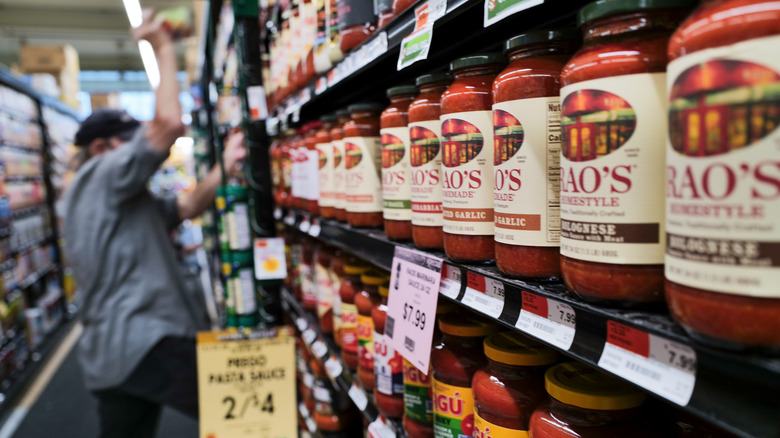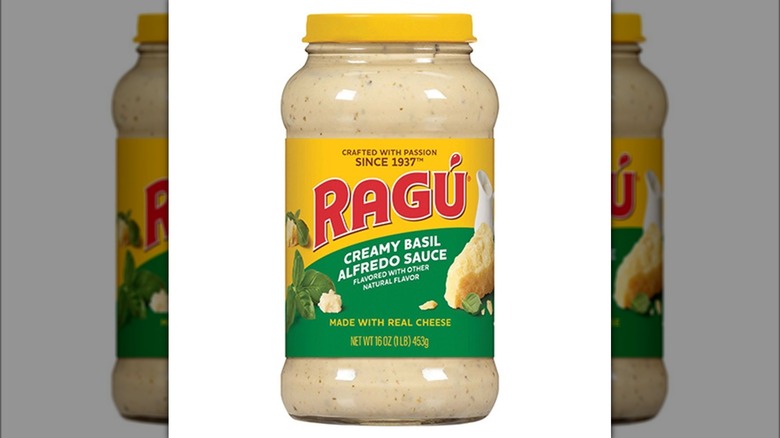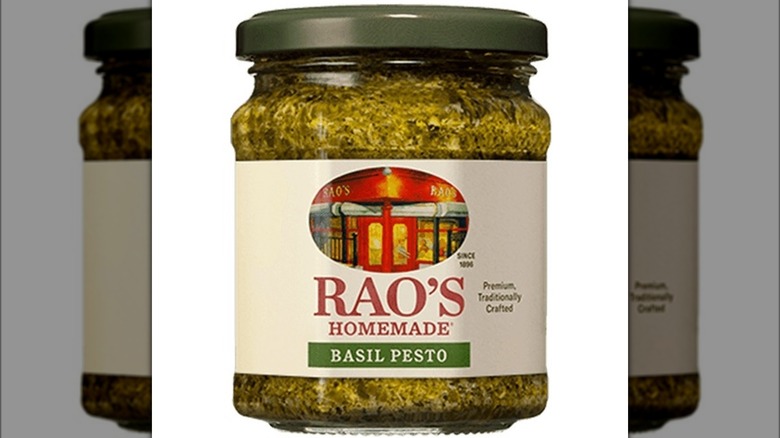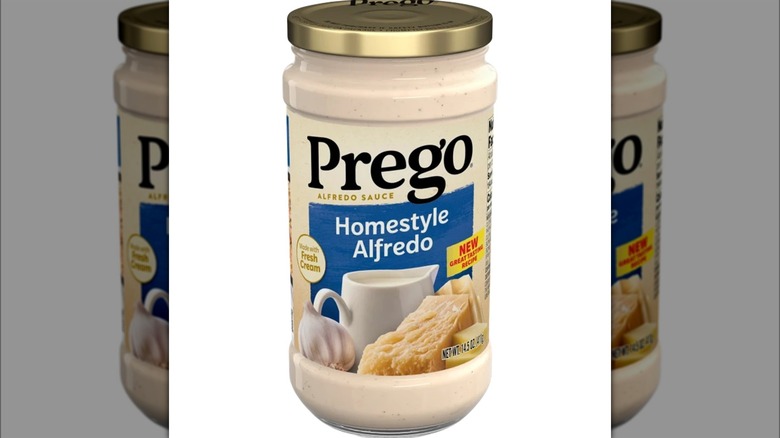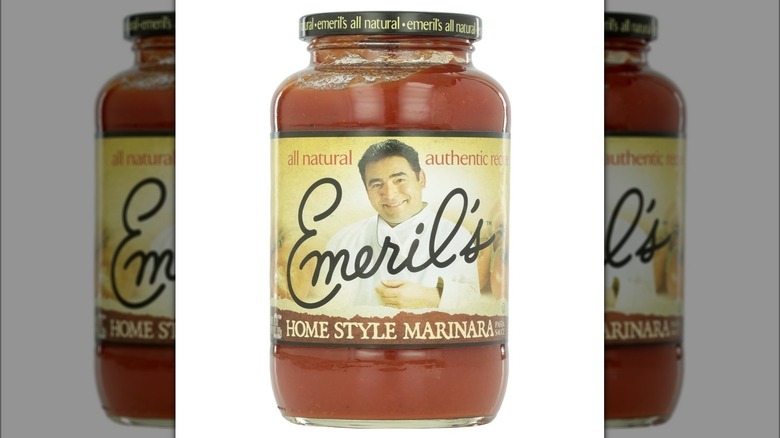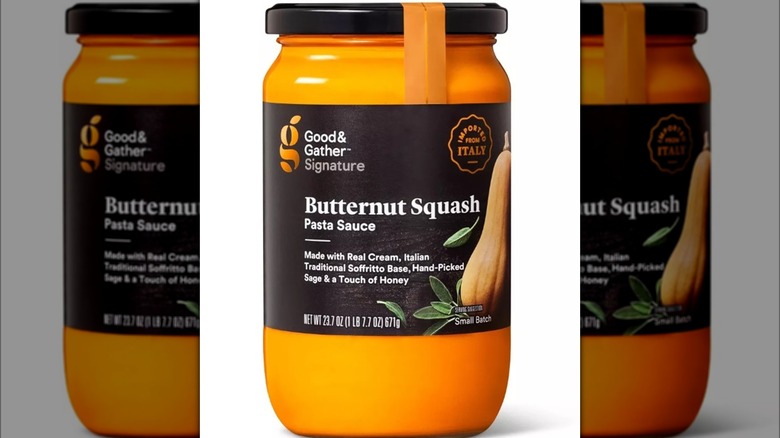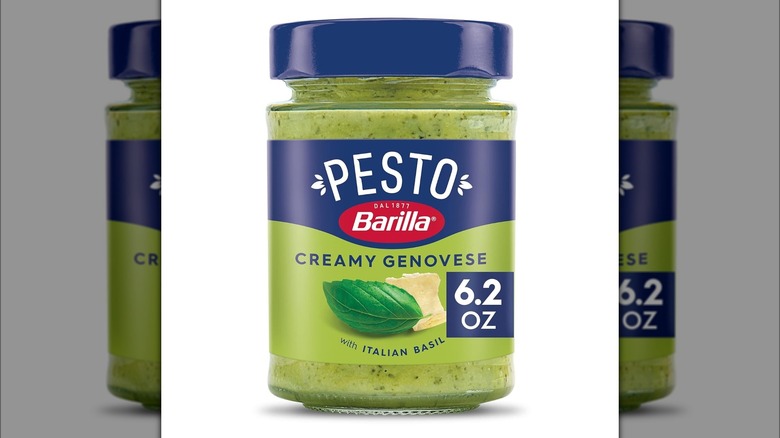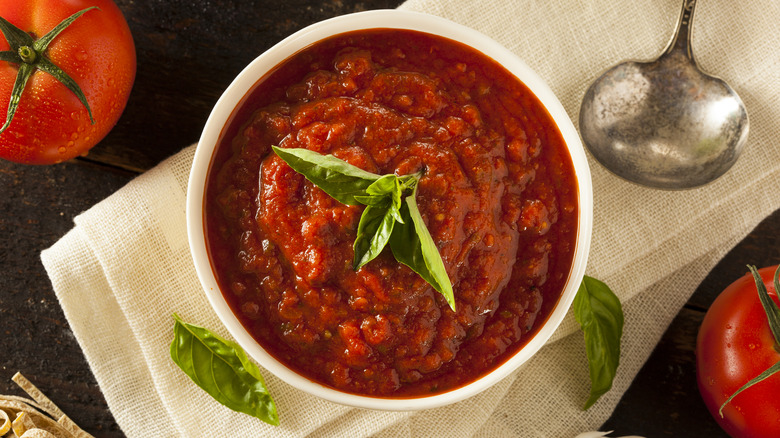The 11 Unhealthiest Pasta Sauces You Can Buy
How unhealthy could a jar of pasta sauce be? At its core, the recipe is a simple combination of tomatoes and seasoning, sometimes sharing the jar with other vegetables, a little cheese, and maybe some ground beef. But when you dig deeper into the recipes used by the most familiar brands, you find more than just these ingredients; there's also a fair amount of oil added, which increases calories and fat. Depending on the formulation, you may discover that pasta sauce exists on a spectrum; at one end are the healthy, low-calorie options that invite indulgence, and at the other are unhealthy concoctions that are better enjoyed in moderation.
To prevent you from making mistakes with your pasta sauce preference, we rounded up the unhealthiest pasta sauces in the marketplace, common brands with uncommonly high concentrations of troublesome ingredients that can detract from an otherwise satisfactory pasta experience. To compare the sauces, we've examined the nutrition information for a half-cup serving of against the FDA's recommendations for a 2,000 daily calorie diet. Guidelines indicate recommended daily allowances of less than 65 grams of fat, less than 2,400 milligrams of sodium, and less than 300 milligrams of cholesterol. We ended up with a variety of red, white, and pesto sauces that challenged those guidelines, and these are just some of the worst offenders.
1. Ragù Creamy Basil Alfredo Sauce
Sauces that contain creamy elements usually weigh in with higher calorie and fat contents. Such is the case with Ragù Creamy Basil Alfredo, especially concerning cholesterol. At 180 calories for a half-cup serving, the numbers are already adding up; comparatively, a serving of Ragù Old World Style Marinara is only 80 calories. With so many calories in Creamy Basil Alfredo, there isn't a lot of wiggle room left for calories in the pasta, veggies, and side dishes you'll likely be enjoying along with the sauce, most of which will come with moderate-to-high calorie counts of their own.
Looking at the fat content, 16 grams per serving is a considerable amount for a pasta topper, about ¼ of the daily recommended intake. Combine that with 660 milligrams of sodium — also about ¼ of the per-day allotment — and you can see why this creation isn't a prime choice from the Ragù sauce selection. A simpler sauce with better numerology would leave wiggle room when it comes to the rest of your meal; Creamy Basil Alfredo adds up to an unwise choice.
2. Rao's Homemade Caramelized Onion
As a premium sauce option, Rao's stands above the rest, giving pasta lovers a higher-end option for dressing out their fettuccine and spaghetti. The company's red sauces are relatively favorable, but when you spin a bottle of Caramelized Onion sauce and check out the label, you find a different story altogether. 120 calories per half-cup serving is 20 more than a half-cup of basic Marinara. It's surprising to learn that including onions in the basic recipe could add 20% more to the calorie count, and not something casual shoppers might think to double-check before putting a jar in their cart.
Luckily, the 8-gram fat content and 330-milligram sodium content keep this ravioli juice from being any more unhealthy than necessary. But if adding a vegetable to the recipe jacks up the calories so considerably, it's probably better to skip the caramelized onions and stick with the ground-level red sauce instead to keep the calorie count in your whole meal under control. At the very least, you can make an informed decision before making your purchase.
3. Rao's Homemade Pesto
When Rao's takes a step beyond the basic tomato-based sauces, the nutritional facts tell a wildly different tale. With no tomatoes in the recipe to provide volume, Rao's Homemade Basil Pesto depends on a heavy concentration of sunflower oil, pine nuts, and cheeses to create a traditional green pesto sauce. Unfortunately, this formula also takes all the questionable aspects into the realm of unmanageable. For a half-cup serving, this jar shares a gobsmacking 640 calories; this alone should give shoppers pause as they consider that number as more than ¼ of a daily 2,000-calorie diet — just for the sauce.
Reading on, the fat content of 62 grams and sodium content of 1,960 milligrams are enough to make you put the jar back on the shelf and slide quietly away from the pasta section altogether. How can a sauce offer such high concentrations of additives that should be kept to a minimum throughout the day? Even cutting the serving in half to a quarter-cup gives your pasta 320 calories, 31 grams of fat, and 980 milligrams of sodium, all without including the pasta itself. Yikes.
4. Prego Homestyle Alfredo
Alfredo is a notoriously indulgent sauce that combines cream and cheese to make a silky white topping for pasta, chicken, and seafood. With Prego Homestyle Alfredo sauce piled on top, those relatively benign foods get an added blast of calories, fat, sodium, and cholesterol that can make simple eating into a complicated affair. You can count on a half-cup serving to add 160 calories, 14 grams of fat, and 780 milligrams of sodium to your plate. If you're tracking your macros closely, that leaves you almost no space for cannoli at the end of your meal.
The biggest surprise in this sauce is the cholesterol count, which at 60 milligrams per serving is higher than any other sauce on the list. While it doesn't come close to the 300 total milligrams allowed per day, it does come in the form of a cream sauce; whatever animal-based proteins you might add on top will only increase your consumption. You could always use less than a half-cup of this Prego sauce, but you'll still be augmenting your pasta with some less-than-desirable elements, something to keep in mind as you shop.
5. Classico Traditional Basil Pesto
With Classico Basil Pesto included in your homestyle Italian meal, you'll be adding one of the least nutritionally impressive sauces currently on the market to your daily consumption. Toss your pasta with a half-cup of this herbaceous temptation and you'll be piling on 460 calories, a staggering 44 grams of fat, and 1,180 milligrams of sodium — just about half of your allowance for the whole day. It makes more sense when you find out the ingredient list includes both soybean and olive oils, but no angel hair pasta dish is worth that kind of trouble.
Another ingredient that makes Classico Basil Pesto nutritionally dubious — even in lesser amounts — is sulfites, something we noticed at the end of the ingredient read-out. Whether they arise naturally from the ingredients or they're added as a preservative, this chemical can be troubling for consumers with sulfite sensitivity. With such undesirable components beneath the lid, there are numerous reasons to skip this sauce and keep searching for something more favorable to flavor your food, or have a go at making your own basil pesto.
6. Emeril's Homestyle Marinara
While marinara is usually a safe choice that keeps calories low while omitting strange additives, Emeril's Homestyle Marinara somehow bucks the trend to create one of the least healthy sauces on the shelf. There may only be 90 calories in a half-cup serving, but it also comes with 430 milligrams of sodium, which is 20% of the daily allowance in the sauce alone. Considering that most pasta makers generously salt the pot when making their noodles, including Emeril's in the meal only adds that much more to the overall content.
Another surprising ingredient that shouldn't be making an appearance in pasta sauce is sugar, and this Homestyle Marinara contains a considerable 9 grams per half-cup serving. Mirroring the sodium, this is 20% of what's advisable to consume in an entire day, and it's all coming in a single serving of pasta sauce. There are far more favorable recipes to use when making jarred sauce, creations that keep the salt and sugar to a minimum. By tossing in the extra to make your meal messier, Emeril's doesn't do the tradition justice.
7. Kroger Traditional Alfredo Sauce
When it comes to house-label pasta sauces, Kroger does a creditable job keeping up with the bigger brands. But when the objective is to keep nutrition as a touchstone, it isn't always a good thing to follow the pack. One example, in particular, is Kroger Traditional Alfredo, a pasta sauce that gives other labels a run for their money in flavor and texture. As for nutritional value, the country's largest grocer also maintains a profile similar to the larger brands ... unfortunately, that means a half-cup serving showers your ziti with 140 calories, 10 grams of fat, and 20 milligrams of cholesterol. You'll also be taking 4 grams of sugar and a heart-shuddering 620 milligrams of sodium.
Kroger creates an attractive price point for its house-label sauces, a factor that's bound to draw the eyes of hungry customers shopping for pasta topping that keeps their checkbooks in check. With so many high counts of undesirable elements included in the bargain, even cost-cutting measures can't help this white sauce measure up in the right way.
8. Good & Gather Signature Butternut Squash Pasta Sauce
Target throws a twist in the less-than-healthy pasta sauce equation with Good & Gather Signature Butternut Squash Pasta Sauce, one of the few gourmet-style recipes around — and sadly, one of the more adverse regarding nutrition. We would have thought a squash-based sauce would have fewer calories than a luscious white sauce, but a half-cup serving of this vibrant orange concoction comes up with 170 calories to make your pasta a heavier prospect. Those calories come with 13 grams of fat, 360 milligrams of sodium, and an incredible 30 milligrams of cholesterol. There are also seven grams of sugar in the recipe, but considering everything else already listed, it's just one more reason to squash this pasta topping possibility.
Where does all of this unfavorable nutritional calculus stem from? Isn't butternut squash supposed to be a healthy option overall? Well, yes ... when it isn't combined with light cream, cultured butter (which includes even more cream), sunflower oil, and cheese. It turns out you can take what nature gave you and turn it into a pasta sauce that's better left on the shelf.
9. Hunt's Mushroom Pasta Sauce
What could a food company do to mushrooms to make them into an unhealthy pasta sauce? If the formulation in question results in Hunt's Mushroom Sauce, the answer is plenty, and most of it has to do with salt. It may be fourth on the list of ingredients, but it accounts for a staggering 640 milligrams in a half-cup serving; countering that phenomenal number with a modest 40 calories. Hunt's Mushroom Sauce presents the highest concentration of sodium found in any of the sauces on our list. It's an eye-popping number that stood out so drastically, we knew it would be one of our wildest finds.
But there's more. The third ingredient shown on the list, coming after tomato paste but before the literal mushrooms in this mushroom sauce, is high fructose corn syrup. Having this troublesome sweetener show up in a higher concentration than mushrooms provides five grams of sugar per serving — in a sauce that shouldn't contain corn syrup of any kind. The bottom line: can this and find something far more considerate of your well-being to pour over your gnocchi.
10. Barilla Creamy Genovese Basil Pesto
When you find a sauce that combines cream and pesto like Barilla Creamy Genovese Basil Pesto does, you can pretty much assume the nutrition facts aren't going to be favorable. The food producer takes an interesting route with its creation, adding sunflower oil and cashews to achieve a richer base than the usual pesto provides. But that also brings in 600 calories per half-cup serving, and where calories occur, fat isn't too far behind; in this case, it's 52 grams, or 67% of your daily allowance. If that weren't enough to deter you from buying, there are also 10 milligrams of cholesterol and 1,520 milligrams of sodium coming along for the ride.
Knowing that a single serving of a jarred pasta sauce can contain more of these elements than you should consume in one sitting makes it clear that shopping for a nutrition-forward pasta sauce is something of a challenge. But options like Barilla Classic Genovese Basil Pesto make it much easier to bypass the unhealthy ones with figures so glaringly out of whack.
11. Bertolli D'Italia Creamy Rosa
Rosa sauce like Bertolli D'Italia Creamy Rosa combines white and red sauce for a recipe made to please lovers of both. This also means the good and bad qualities of both sauces ride shotgun with one another out of the jar. In the case of this tangy-creamy mix, a half-cup serving shows up on the plate with 100 calories, a bit higher than the average red sauce, though lower than some white sauces on the market. The 6 grams of fat aren't the worst, either, considering the inclusion of Alfredo-like ingredients. But the 590 milligrams of sodium should be a dealbreaker, putting 25% of your recommended consumption into one overindulgent element of your meal.
Having two different types of cheese plus eggs in the jar might explain the 15 milligrams of cholesterol in this sauce, too. With so much working against the notion of eating for health dropped into a twofer sauce like this one, you might be happier choosing a marinara you can doctor with your own, more nutritious white sauce ingredients instead.
How we chose our sauces
To find the most unhealthy pasta sauces around, we headed for the pasta aisle and rooted through the biggest brands, as well as checking store signature labels and lesser-known jars. We assessed the per-serving contents for calories, fat, sugar, sodium, and cholesterol. We then compared them to the FDA's daily recommendation guidelines to find the least healthy options. Not all sauces we chose were unfavorable in all areas; some sauces were higher-calorie but lower-sugar, while others were lower-calorie but higher-sodium. The worst offenders became the best candidates for the list. While enjoying pasta sauce in moderation can mitigate the negative impact on your health and nutrition goals, some sauces are shockingly unhealthy and are better avoided.
Checking the labels confirmed our suspicions that the most unhealthy pasta sauces weren't just the traditional marinara sauces, but also pesto and Alfredo, concoctions that incorporate ingredients beyond the usual tomatoes-herbs-and-oil blend. While it wasn't surprising to learn these were less nutritious, seeing how much higher the numbers on the labels were was a real learning experience. We also found that servings are generally listed as one half-cup, though some use one quarter-cup instead; to keep things even among all sauces, we used one half-cup as the standard serving and adjusted the nutrient values accordingly.
